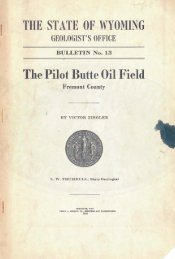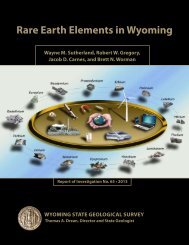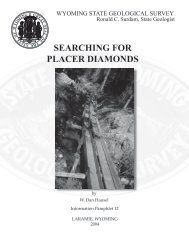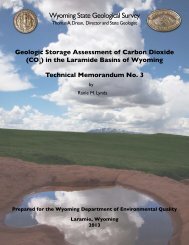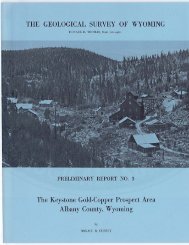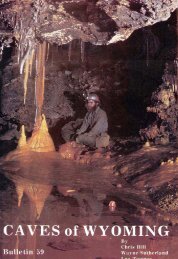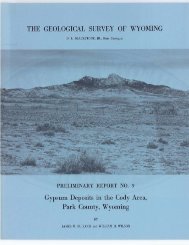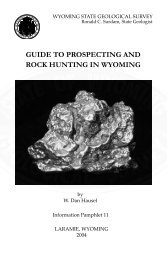The Dinosaurs of Wyoming - Wyoming State Geological Survey ...
The Dinosaurs of Wyoming - Wyoming State Geological Survey ...
The Dinosaurs of Wyoming - Wyoming State Geological Survey ...
Create successful ePaper yourself
Turn your PDF publications into a flip-book with our unique Google optimized e-Paper software.
38 THE DINOSACRS OF WYOMING<br />
<strong>The</strong> hugest <strong>of</strong> these had to be lifted fifty feet out <strong>of</strong>a vertical<br />
ravine, and hauled 40 miles to the railroad over a trackless<br />
country and across unknown streams. Hatcher revolutionized<br />
the collecting <strong>of</strong> fossil vertebrates, introducing many new<br />
procedures. He was later assigned the task <strong>of</strong> completing the<br />
memoir on the Ceratopsia, which he did not live to complete.<br />
While not a highly educated man, Hatcher trained himself by<br />
observation and reading so that he was able to write a number<br />
<strong>of</strong> valuable scientific papers relating to stratigraphy and vertebrate<br />
paleontology. His work at Princeton was on the<br />
fossil mammals <strong>of</strong> Patagonia, and at the Carnegie Museum he<br />
assembled from Colorado and <strong>Wyoming</strong> important sauropod<br />
skeletons, at present mounted in the Museum.<br />
Pr<strong>of</strong>essor R. S. Lull, director <strong>of</strong> the Peabody Museum and<br />
Pr<strong>of</strong>essor <strong>of</strong> Paleontology at Yale University, has enhanced<br />
the value <strong>of</strong> the dinosaur collections left by Marsh, by numerous<br />
scientific papers, memoirs and the completion <strong>of</strong> the monograph<br />
on Ceratopsia, as well as by further collecting. His<br />
revision <strong>of</strong> dinosaur footprints from the eastern Triassic is a<br />
monument <strong>of</strong> industry in a difficult field.<br />
Pr<strong>of</strong>essor E. D. Cope, <strong>of</strong> Philadelphia, sent expeditions<br />
into the west after 1869. One collector he employed, J. L.<br />
Wortman, rose to an independent position in science by his<br />
sagacity and application. Cope's large dinosaurs came in part<br />
from Colorado, as well as other states. His quarry at Garden<br />
Park, Colorado, was still open in 1907 when I visited it. All<br />
<strong>of</strong> Cope's collections were acquired through purchase by the<br />
American Museum <strong>of</strong> Natural History and the sauropod skeletons<br />
are being restudied.<br />
Realizing the importance <strong>of</strong> the finds being made in <strong>Wyoming</strong><br />
Pr<strong>of</strong>essor Wilbur C. Knight conducted successful expeditions<br />
into the dinosaur fossil beds for the museum at the<br />
University <strong>of</strong> <strong>Wyoming</strong>. <strong>The</strong> aquatic reptiles, called plesiosaurs,<br />
attracted his attention and he described these in a short<br />
series <strong>of</strong> scientific papers.<br />
<strong>The</strong> Field Museum <strong>of</strong> Tatural History, at Chicago, possesses<br />
a good collection <strong>of</strong> sauropod dinosau"rs, collected and<br />
prepared under the supervision <strong>of</strong> E. S. Riggs, whose teacher<br />
in paleontology was Williston at Kansas University. Riggs<br />
collected in Colorado and eastern <strong>Wyoming</strong>, making a noteworthy<br />
discovery <strong>of</strong> a dinosaur whose fore lim bs were longer<br />
than the hind limbs: the upper arm bone measuring nearly<br />
seven feet in length. A partial skeleton <strong>of</strong> Brontosaurus is<br />
mounted in Field Museum.<br />
<strong>The</strong> Carnegie Museum, at Pittsburgh, has a noteworthy<br />
collection <strong>of</strong> dinosaurian material, collected in part from Wyo-




